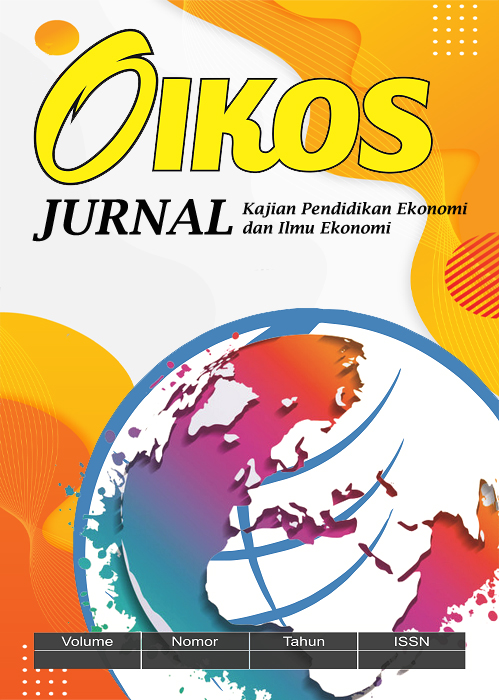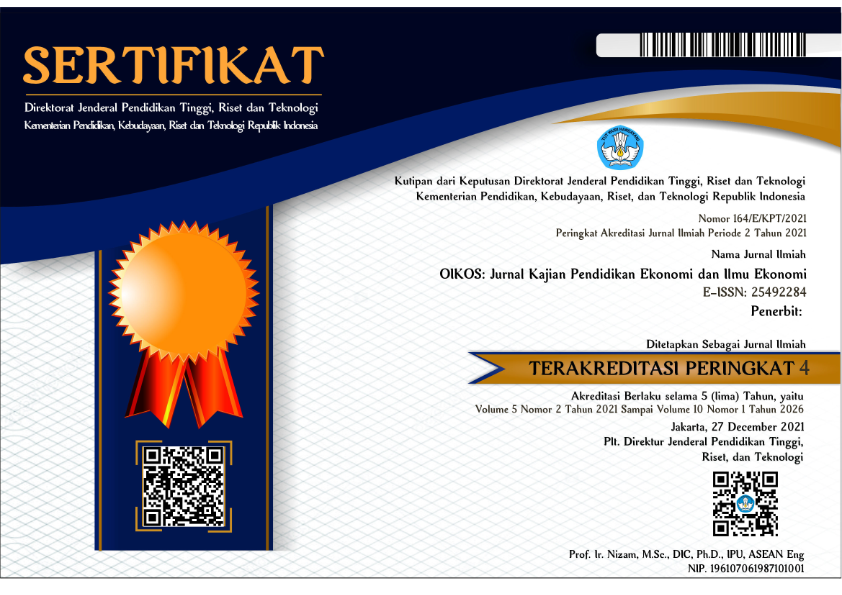PENGARUH PERCEIVED TRUST DAN PERCEIVED ENJOYMENT TERHADAP PERILAKU PENGGUNAAN SHOPEEPAY
DOI:
https://doi.org/10.23969/oikos.v8i2.13757Keywords:
Perceived Trust, Perceived Enjoyment, Shopeepay Usage BehaviorAbstract
Penelitian ini bertujuan untuk mengetahui pengaruh Perceived Trust dan Perceived Enjoyment terhadap perilaku penggunaan ShopeePay. Penelitian ini menggunakan penelitian kuantitatif sebanyak 96 responden di Kabupaten Jombang Pengguna, atau masyarakat yang sudah pernah menggunakan ShopeePay sebagai alat transaksi dan tempat menyimpan uang. Metode yang digunakan dalam pengumpulan data adalah dengan mendistribusikan kuisioner dan teknik dalam pengumpulan data menggunakan Teknik convenience sampling. Teknik analisis data menggunakan metode analisis regresi linier berganda, uji validitas dan reliabilitas, uji F, uji t, koefesien korelasi dan determinasi dengan menggunakan software, SPSS 25. Hasil penelitian ini menunjukkan bahwa perceived trust memberikan pengaruh yang tidak signifikan terhadap perilaku penggunaan. Menunjukkan bahwa perceived enjoyment memberikan pengaruh yang signifikan terhadap perilaku penggunaan Perceived Trust dan Perceived Enjoyment secara simultan terhadap perilaku penggunaan.
Downloads
References
Bank Indonesia. (2016). PBI No. 18/40/2016. 236, 3–4.
Beldad, A. D., & Hegner, S. M. (2018). Expanding the Technology Acceptance Model With the Inclusion of Trust, Social Influence, and Health Valuation to Determine the Predictors of German Users’ Willingness to Continue Using a Fitness App: A Structural Equation Modeling Approach. International Journal of Human-Computer Interaction, 34(9), 882–893. https://doi.org/10.1080/10447318.2017.1403220
Damanik, M. A. A., Fauzi, A., & Situmorang, S. H. (2022). Pengaruh Perceived Usefulness, Perceived Enjoyment dan Kepercayaan Terhadap Continuance Intention Melalui Kepuasan Pada Generasi Millenial Pengguna E-Wallet di Kota Medan. Ekonomi, Keuangan, Investasi Dan Syariah (EKUITAS), 3(4), 827–834. https://doi.org/10.47065/ekuitas.v3i4.1475
Fintech indonesia. (2020). Tentang Aplikasi ShopeePay. https://shopeepay.co.id/
Hammouri, Q., Aloqool, A., Saleh, B. A., Aldossary, H., Al Frejat, S. Y., Halim, M., Almajali, D. A., Al-Gasawneh, J. A., & Darawsheh, S. D. R. (2023). An Empirical Investigation on Acceptance of e-wallets in the fintech Era in Jordan: Extending UTAUT2 Model With Perceived Trust. International Journal of Data and Network Science, 7(3), 1249–1258. https://doi.org/10.5267/j.ijdns.2023.4.013
Hanif, R. (2022). Menentukan Loyalitas Pengguna Shopeepay Berdasarkan User Experience Dan Kepercayaan Pelanggan. Jurnal Ilmiah Bisnis Dan Ekonomi Asia, 16(1), 164–172. https://doi.org/10.32812/jibeka.v16i1.969
IDN TIMES. (2022). E-Wallet Paling Sering Digunakan Masyarakat di 2022. IDN TIMES.COM. https://www.idntimes.com/business/economy/trio-hamdani/ini-10-e-wallet-paling-sering-digunakan-masyarakat-di
Juniwati, J. (2015). Pengaruh Perceived Ease of Use, Enjoyment dan Trust Terhadap Repurchase Intention dengan Customer Satisfaction Sebagai Intervening pada Belanja Online (Studi Pada Mahasiswa Universitas Tanjungpura Pontianak). Jurnal Ekonomi Bisnis Dan Kewirausahaan, 4(1), 140. https://doi.org/10.26418/jebik.v4i1.11465
Kominfo. (2021). Pandemi Covid-19 Pacu Adaptasi Gunakan Teknologi Digital. Kominfo.Com. https://www.kominfo.go.id/content/detail/32602/pandemi-covid-19-pacu-adaptasi-gunakan-teknologi digital/0/berita_satker
Lewis, J. D., & Weigert, A. (1985). Trust as a Social Reality. Social Forces, 63(4), 967–985. https://doi.org/10.1093/sf/63.4.967
Mayer, R. C., Davis, J. H., & Schoorman, F. D. (1995). An Integrative Model Of Organizational Trust. Academy of Management Review, 20(3), 709–734. https://doi.org/10.5465/amr.1995.9508080335
Meida, L., & Trifiyanto, K. (2022). Pengaruh Perceived Trust dan Perceived Risk Terhadap Behavioral Intention dengan Perceived Ease of Use sebagai Variabel Intervening. Jurnal Ilmiah Mahasiswa Manajemen, 4(2), 217–232. https://jurnal.universitasputrabangsa.ac.id/index.php/jimmba/index
Mulyana, A., & Wijaya, H. (2018). Perancangan E-Payment System pada E-Wallet Menggunakan Kode QR Berbasis Android. Komputika : Jurnal Sistem Komputer, 7(2), 63–69. https://doi.org/10.34010/komputika.v7i2.1511
Nimas Bidari, L., & Kurniawan, I. (2023). The Influence of Brand Ambassador and Brand Image on Skincare Products on Purchase Interest. Enrichment: Journal of Management, 13(2).
Oktariani, M. A. S., & Wardana, I. M. (2018). Peran Customer Satisfaction Memediasi Perceived Ease of Use dan Perceived Enjoyment Teradap Repurcase Intention. 7(4), 2041–2072.
Oktarini, M. A. S., & Wardana, I. M. (2018). Pengaruh Perceived Ease Of Use Dan Perceived Enjoyment Terhadap Customer Satisfaction Dan Repurchase Intention. INOBIS: Jurnal Inovasi Bisnis Dan Manajemen Indonesia, 1(2), 227–237. https://doi.org/10.31842/jurnal-inobis.v1i2.32
Pratamasari, A. (2020). Cybersecurity and Custom Regulations as Trade Barriers in ASEAN e-Commerce: Case of Indonesian e-Commerce. Jurnal Global & Strategis, 14(1), 1. https://doi.org/10.20473/jgs.14.1.2020.1-16
Pratiwi, S., & Sofwan, A. (2022). Pengaruh Perceived Usefulness, Perceived Ease of Use, Perceived Risk dan Trust Terhadap Minat Menggunakan Fintech Shopeepay. Jurnal Rekognisi Akuntansi, 6(2), 141–154. https://doi.org/10.34001/jra.v6i2.434
Riskiyadi, M., Anggono, A., & Tarjo. (2021). Cybercrime dan Cybersecurity pada Fintech: Sebuah Tinjauan Pustaka Sistematis. Jurnal Manajemen Dan Organisasi, 12(3), 239–251. https://doi.org/10.29244/jmo.v12i3.33528
Rutinaias, H. (2021). Pengaruh Preferensi Pelanggan, Perilaku Konsumen dan Brand Image Terhadap Loyalitas Pelanggan (Studi Kasus pada Pengguna Sepeda Motor Honda CBR di Kalbis Institute, Jakarta Timur) [Skripsi].
Setyawan, F., & Kurniawan, I. (2023). Enrichment: Journal of Management The influence of customer experience and destination image on interest to return visit. Enrichment: Journal of Management, 13(2).
Shopee. (2020). E-wallet Paling Sering Digunakan Masyarakat di 2022. Shopee. https://help.shopee.co.id/portal/4/article/73240-[Aktivasi-ShopeePay]-Apa-itu-ShopeePay-dan-bagaimana-cara-aktivasinya%3F
Sudono, F. S., Adiwijaya, M., & Siagian, H. (2020). The Influence of Perceived Security and Perceived Enjoyment on Intention To Use with Attitude Towards Use as Intervening Variable on Mobile Payment Customer in Surabaya. Petra International Journal of Business Studies, 3(1), 37–46. https://doi.org/10.9744/ijbs.3.1.37-46
Van Der Heijden, H. (2004). Van der Heijden/Hedonic Information Systems v iiicir c i Iv research n?te User Acceptance of Hedonic information systems1. Source: MIS Quarterly, 28(4), 695–704.
Venkatesh, V., Thong, J. Y. L., & Xin Xu. (2012). Consumer Sebuah Ceptance dan Use Of Saya Informasi Technology : Extending The Unified Theory. MIS Quarterly, 36(1), 157–178.
Downloads
Published
Issue
Section
License
Copyright (c) 2024 OIKOS: Jurnal Kajian Pendidikan Ekonomi dan Ilmu Ekonomi

This work is licensed under a Creative Commons Attribution 4.0 International License.









